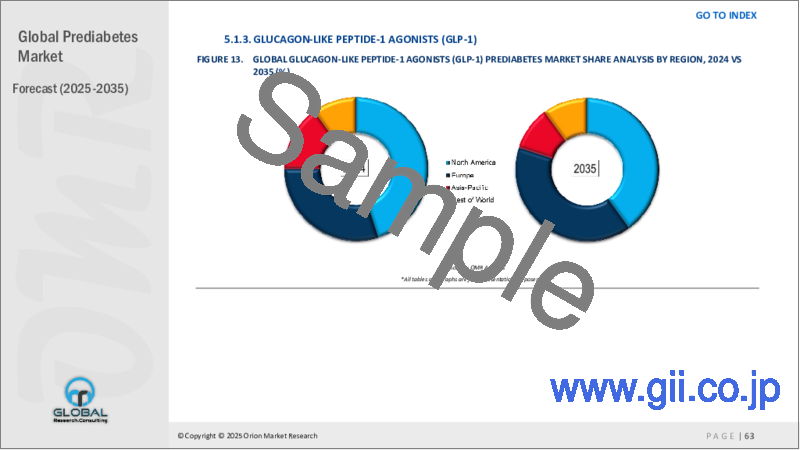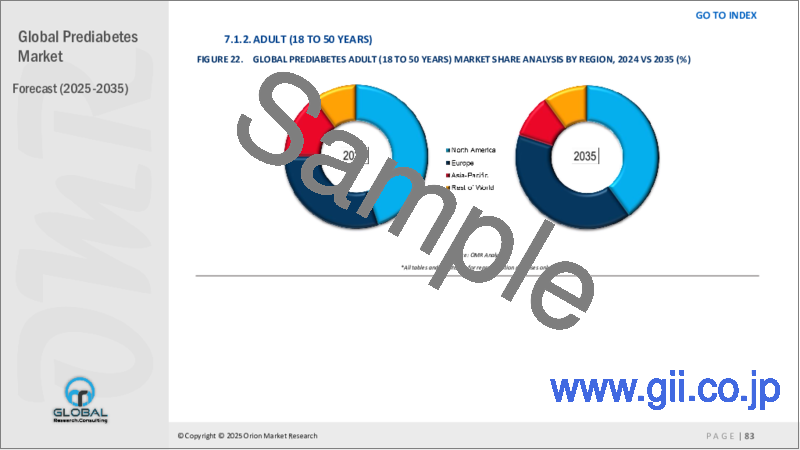|
|
市場調査レポート
商品コード
1483047
糖尿病前症の世界市場:2024~2031年Global Prediabetes Market 2024-2031 |
||||||
カスタマイズ可能
|
|||||||
| 糖尿病前症の世界市場:2024~2031年 |
|
出版日: 2024年03月19日
発行: Orion Market Research
ページ情報: 英文 125 Pages
納期: 2~3営業日
|
全表示
- 概要
- 図表
- 目次
糖尿病前症市場は予測期間(2024-2031年)にCAGR 7.2%で成長すると予測されます。糖尿病前症とは、標準的な耐糖能と診断された糖尿病の中間に位置する糖調節異常の中間段階を指します。これは、2型糖尿病と分類されるほど高くない血糖値の上昇を特徴とする状態です。
市場力学
糖尿病前症市場における技術革新の進展
糖尿病前症市場における技術革新は、早期発見を可能にする高度な診断ツールによって大きな進歩をもたらしています。個別化された治療アプローチと新たな治療薬は、疾患の進行を止めることを目的としています。デジタルヘルスソリューションは、患者のモニタリングとエンゲージメントを強化します。これらの技術革新は、糖尿病前症管理を再構築し、転帰を改善し、2型糖尿病のリスクを低減しています。特に、糖尿病前症や境界型糖尿病の患者管理に関しては、痛みを伴わないグルコースモニター、モバイルヘルスアプリ、パーソナライズされたデジタルコーチングなどの新技術の登場により、患者の満足度が大幅に向上し、ケアにおけるギャップが解消されています。
持続グルコースモニタリング(CGM)装置の採用増加
世界的に、グルコースレベルに関するリアルタイムのフィードバックを提供し、管理アクションを促進するCGMデバイスの採用が増加しており、市場の成長をさらに強化しています。これらのガジェットは、幼児、妊娠中の人、高齢者、健康状態を併発している人などのグループの糖尿病を監督するのに有益であることが証明されています。たとえば、2023年3月、米国国立生物工学情報センター(NCBI)によると、糖尿病前症の患者は食後グルコースレベルが上昇しており、CGMの利用が行動修正の引き金となり、糖尿病の発症を先延ばしできる可能性があります。糖尿病前症の診断技術の採用が増加していることが、糖尿病治療に対する需要を押し上げています。
ジグアナイド製剤が最大セグメントとなる見込み
薬剤クラス別では、世界の糖尿病前症市場はジグアナイド系とチアゾリジン系に細分化されます。このうち、ジグアナイド系サブセグメントが市場の最大シェアを占めると予想されています。このセグメントの成長を支える主な要因としては、メトホルミンを含む薬剤クラス別であり、糖尿病前症や2型糖尿病の治療に広く使用されているジグアナイド薬が挙げられます。例えば、2023年8月、米国国立生物工学情報センター(NCBI)によると、メトホルミンは、成人および10歳以上の小児患者における糖尿病前症管理のための唯一の米国糖尿病学会(ADA)推奨薬となっています。
成人のサブセグメントが大きな市場シェアを占める
不健康なライフスタイルの増加が、この年齢層セグメントの成長を牽引しています。高齢、糖尿病の家族歴、妊娠糖尿病の既往歴、多嚢胞性卵巣症候群、高血圧の既往歴、心血管疾患、脂質異常症の既往歴、リスクの高い人種/民族、運動不足などが糖尿病前症のリスクを高めています。例えば、2021年に米国疾病管理センター(CDC)は、9,600万人の米国人(成人人口の38%)が糖尿病前症であると推定しており、これまで安定していた糖尿病前症の人口比率が増加していることを示しています。
地域別展望
世界の糖尿病前症市場は、北米(米国、カナダ)、欧州(英国、イタリア、スペイン、ドイツ、フランス、その他欧州地域)、アジア太平洋地域(インド、中国、日本、韓国、その他アジア地域)、世界のその他の地域(中東とアフリカ、ラテンアメリカ)を含む地域別にさらに細分化されています。
糖尿病前症市場に投資する欧州諸国
- フランスは、ヘルスケア利害関係者間の協力的な取り組みが、診断技術への投資の増加とともに、糖尿病前症管理における予防対策の強化と治療成績の改善に極めて重要です。
- 英国の糖尿病前症市場は、認知度の向上、診断技術の進歩、早期診断への注力といった要因によって拡大すると予測されます。
糖尿病前症の世界市場成長:地域別、2024~2031年
北米が主要市場シェアを占める
全地域の中で北米が大きなシェアを占めています。これは、糖尿病予備群の有病率の高さ、疾病を引き起こすライフスタイルの採用増加、整備されたヘルスケアインフラ、疾病の早期発見の重視によるものです。糖尿病有病率の上昇と相まって、糖尿病前症の早期発見と介入の重要性に対する認識が高まっていることが、市場の拡大に拍車をかけています。
例えば、2021年の米国糖尿病協会(ADA)によると、米国では18歳以上の成人9,760万人に糖尿病前症が認められました。また、診断技術や治療オプションの進歩が糖尿病前症管理戦略の有効性を高めています。さらに、スクリーニング、診断、管理ソリューションの需要を高める高齢者人口の増加などの重要な理由により、米国の糖尿病前症市場は業界をリードしています。第二に、継続的なモニタリングとテーラーメイド治療を可能にすることで、ウェアラブルやデジタルヘルスプラットフォームのような技術革新が糖尿病前症の管理を変革しつつあります。さらに、食事療法や生活習慣の調整を含む、糖尿病前症を管理するための包括的な戦略の動向も現れています。
目次
第1章 レポート概要
- 業界の現状分析と成長ポテンシャルの展望
- 調査方法とツール
- 市場内訳
- セグメント別
- 地域別
第2章 市場概要と洞察
- 調査範囲
- アナリストの洞察と現在の市場動向
- 主な調査結果
- 推奨事項
- 結論
第3章 競合情勢
- 主要企業分析
- Novo Nordisk A/S
- 概要
- 財務分析
- SWOT分析
- 最近の動向
- Valbiotis
- 会社概要
- 財務分析
- SWOT分析
- 最近の動向
- Resverlogix Corp.
- 概要
- 財務分析
- SWOT分析
- 最近の動向
- 主要戦略分析
第4章 市場セグメンテーション
- 糖尿病前症の世界市場:薬剤クラス別
- ジグアナイド薬
- チアゾリジン系薬剤(TZDs)
- グルカゴン様ペプチド-1作動薬(GLP-1)
- SGLT2阻害薬
- DPP-4阻害薬
- その他(グルカゴン様ペプチド-1(GLP-1)、スルホニル尿素薬)
- 糖尿病前症の世界市場:年齢層別
- 小児(12~18歳)
- 成人(18~50歳)
- 高齢者(50歳以上)
第5章 地域別分析
- 北米
- 米国
- カナダ
- 欧州
- 英国
- ドイツ
- イタリア
- スペイン
- フランス
- その他欧州
- アジア太平洋
- 中国
- インド
- 日本
- 韓国
- その他アジア太平洋地域
- 世界のその他の地域
第6章 企業プロファイル
- Aphaia Pharma
- AstraZeneca
- Boehringer Ingelheim International GmbH
- Boston Pharmaceuticals
- Bristol-Myers Squibb
- Caelus Health
- Dexcom, Inc.
- DIABETOMICS, Inc.
- Eli Lilly and Company
- Johnson & Johnson Services, Inc.
- Medtronic Private Limited
- Merck KGaA
- Sanofi Group
- SciMar Ltd.
- TeleMed2U Inc.
LIST OF TABLES
- 1.GLOBAL PREDIABETES MARKET RESEARCH AND ANALYSIS BY DRUG CLASS, 2023-2031 ($ MILLION)
- 2.GLOBAL DIGUANIDE FOR PREDIABETES MARKET RESEARCH AND ANALYSIS BY REGION, 2023-2031 ($ MILLION)
- 3.GLOBAL TZDS FOR PREDIABETES MARKET RESEARCH AND ANALYSIS BY REGION, 2023-2031 ($ MILLION)
- 4.GLOBAL GLP-1 FOR PREDIABETES MARKET RESEARCH AND ANALYSIS BY REGION, 2023-2031 ($ MILLION)
- 5.GLOBAL SGLT2 INHIBITORS FOR PREDIABETES MARKET RESEARCH AND ANALYSIS BY REGION, 2023-2031 ($ MILLION)
- 6.GLOBAL DPP-4 INHIBITORS FOR PREDIABETES MARKET RESEARCH AND ANALYSIS BY REGION, 2023-2031 ($ MILLION)
- 7.GLOBAL OTHER DRUG CLASSES FOR PREDIABETES MARKET RESEARCH AND ANALYSIS BY REGION, 2023-2031 ($ MILLION)
- 8.GLOBAL PREDIABETES MARKET RESEARCH AND ANALYSIS BY AGE GROUP, 2023-2031 ($ MILLION)
- 9.GLOBAL PREDIABETES IN CHILDREN MARKET RESEARCH AND ANALYSIS BY REGION, 2023-2031 ($ MILLION)
- 10.GLOBAL PREDIABETES IN ADULT MARKET RESEARCH AND ANALYSIS BY REGION, 2023-2031 ($ MILLION)
- 11.GLOBAL PREDIABETES IN ELDERLY MARKET RESEARCH AND ANALYSIS BY REGION, 2023-2031 ($ MILLION)
- 12.GLOBAL PREDIABETES MARKET RESEARCH AND ANALYSIS BY REGION, 2023-2031 ($ MILLION)
- 13.NORTH AMERICAN PREDIABETES MARKET RESEARCH AND ANALYSIS BY COUNTRY, 2023-2031 ($ MILLION)
- 14.NORTH AMERICAN PREDIABETES MARKET RESEARCH AND ANALYSIS BY DRUG CLASS, 2023-2031 ($ MILLION)
- 15.NORTH AMERICAN PREDIABETES MARKET RESEARCH AND ANALYSIS BY AGE GROUP, 2023-2031 ($ MILLION)
- 16.EUROPEAN PREDIABETES MARKET RESEARCH AND ANALYSIS BY COUNTRY, 2023-2031 ($ MILLION)
- 17.EUROPEAN PREDIABETES MARKET RESEARCH AND ANALYSIS BY DRUG CLASS, 2023-2031 ($ MILLION)
- 18.EUROPEAN PREDIABETES MARKET RESEARCH AND ANALYSIS BY AGE GROUP, 2023-2031 ($ MILLION)
- 19.ASIA-PACIFIC PREDIABETES MARKET RESEARCH AND ANALYSIS BY COUNTRY, 2023-2031 ($ MILLION)
- 20.ASIA-PACIFIC PREDIABETES MARKET RESEARCH AND ANALYSIS BY DRUG CLASS, 2023-2031 ($ MILLION)
- 21.ASIA-PACIFIC PREDIABETES MARKET RESEARCH AND ANALYSIS BY AGE GROUP, 2023-2031 ($ MILLION)
- 22.REST OF THE WORLD PREDIABETES MARKET RESEARCH AND ANALYSIS BY REGION, 2023-2031 ($ MILLION)
- 23.REST OF THE WORLD PREDIABETES MARKET RESEARCH AND ANALYSIS BY DRUG CLASS, 2023-2031 ($ MILLION)
- 24.REST OF THE WORLD PREDIABETES MARKET RESEARCH AND ANALYSIS BY AGE GROUP, 2023-2031 ($ MILLION)
LIST OF FIGURES
- 1.GLOBAL PREDIABETES MARKET SHARE BY DRUG CLASS, 2023 VS 2031 (%)
- 2.GLOBAL DIGUANIDE FOR PREDIABETES MARKET SHARE BY REGION, 2023 VS 2031 (%)
- 3.GLOBAL TZDS FOR PREDIABETES MARKET SHARE BY REGION, 2023 VS 2031 (%)
- 4.GLOBAL GLP-1 FOR PREDIABETES MARKET SHARE BY REGION, 2023 VS 2031 (%)
- 5.GLOBAL SGLT2 INHIBITORS FOR PREDIABETES MARKET SHARE BY REGION, 2023 VS 2031 (%)
- 6.GLOBAL DPP-4 INHIBITORS FOR PREDIABETES MARKET SHARE BY REGION, 2023 VS 2031 (%)
- 7.GLOBAL OTHER DRUG CLASSES FOR PREDIABETES MARKET SHARE BY REGION, 2023 VS 2031 (%)
- 8.GLOBAL PREDIABETES MARKET SHARE BY AGE GROUP, 2023 VS 2031 (%)
- 9.GLOBAL PREDIABETES IN CHILDREN MARKET SHARE BY REGION, 2023 VS 2031 (%)
- 10.GLOBAL PREDIABETES IN ADULT MARKET SHARE BY REGION, 2023 VS 2031 (%)
- 11.GLOBAL PREDIABETES IN ELDERLY MARKET SHARE BY REGION, 2023 VS 2031 (%)
- 12.GLOBAL PREDIABETES MARKET SHARE BY REGION, 2023 VS 2031 (%)
- 13.US PREDIABETES MARKET SIZE, 2023-2031 ($ MILLION)
- 14.CANADA PREDIABETES MARKET SIZE, 2023-2031 ($ MILLION)
- 15.UK PREDIABETES MARKET SIZE, 2023-2031 ($ MILLION)
- 16.FRANCE PREDIABETES MARKET SIZE, 2023-2031 ($ MILLION)
- 17.GERMANY PREDIABETES MARKET SIZE, 2023-2031 ($ MILLION)
- 18.ITALY PREDIABETES MARKET SIZE, 2023-2031 ($ MILLION)
- 19.SPAIN PREDIABETES MARKET SIZE, 2023-2031 ($ MILLION)
- 20.REST OF EUROPE PREDIABETES MARKET SIZE, 2023-2031 ($ MILLION)
- 21.INDIA PREDIABETES MARKET SIZE, 2023-2031 ($ MILLION)
- 22.CHINA PREDIABETES MARKET SIZE, 2023-2031 ($ MILLION)
- 23.JAPAN PREDIABETES MARKET SIZE, 2023-2031 ($ MILLION)
- 24.SOUTH KOREA PREDIABETES MARKET SIZE, 2023-2031 ($ MILLION)
- 25.REST OF ASIA-PACIFIC PREDIABETES MARKET SIZE, 2023-2031 ($ MILLION)
- 26.LATIN AMERICA PREDIABETES MARKET SIZE, 2023-2031 ($ MILLION)
- 27.THE MIDDLE EAST AND AFRICA PREDIABETES MARKET SIZE, 2023-2031 ($ MILLION)
Prediabetes Market Size, Share & Trends Analysis Report by Drug Class (Diguanide, Thiazolidinediones (TZDs), Glucagon-like Peptide-1 Agonists (GLP-1), SGLT2 Inhibitors, DPP-4 Inhibitors, and Others), and by Age Group (Children, Adult, and Elderly) Forecast Period (2024-2031)
Prediabetes market is anticipated to grow at a CAGR of 7.2% during the forecast period (2024-2031). Prediabetes refers to an intermediate stage of glucose dysregulation situated between standard glucose tolerance and diagnosed diabetes. It is a condition characterized by elevated blood sugar levels that are not high enough to be classified as Type 2 diabetes.
Market Dynamics
Growing innovation in the prediabetes market
Innovations in the prediabetes market are driving significant progress, with advanced diagnostic tools enabling early detection. Personalized treatment approaches and emerging therapeutics aim to cease disease progression. Digital health solutions enhance patient monitoring and engagement. These innovations are reshaping prediabetes management, improving outcomes, and reducing the risk of type 2 diabetes. Notably, when it comes to managing patients with prediabetes and borderline diabetes, the emergence of new technologies like painless glucose monitors, mobile health apps, and personalized digital coaching have significantly improved patient satisfaction and bridged the gap in care.
Rising adoption of continuous glucose monitoring (CGM) devices
Globally, the rising adoption of CGM devices, which provide real-time feedback on glucose levels and facilitate management actions, further strengthens market growth. These gadgets prove beneficial in overseeing diabetes among groups like toddlers, pregnant individuals, the elderly, and those with concurrent health conditions. For instance, in March 2023, according to the National Center for Biotechnology Information (NCBI), individuals with prediabetes experienced heightened postprandial glucose levels, and the utilization of CGM could trigger behavioral modifications, potentially postponing the onset of diabetes. The increasing adoption of technology for diagnosing prediabetes in turn is boosting the demand for its treatment.
Market Segmentation
Our in-depth analysis of the global prediabetes market includes the following segments by drug class and age group:
- Based on drug class, the market is sub-segmented into diguanide, TZDs, GLP-1, SGLT2 inhibitors, DPP-4 inhibitors, and others (Glucagon-like peptide 1 (GLP-1), Sulfonylureas).
- Based on age group, the market is bifurcated into children (aged 12 to 18 years), adults (aged 18 to 50 years), and elderly (above 50 years).
Diguanide is Projected to Emerge as the Largest Segment
Based on the drug class, the global prediabetes market is sub-segmented into diguanide and thiazolidinediones. Among these, the diguanide sub-segment is expected to hold the largest share of the market. The primary factor supporting the segment's growth includes diguanides as it is a class of drugs that includes metformin, and is widely used in the treatment of prediabetes and type 2 diabetes. For instance, in August 2023, according to the National Center for Biotechnology Information (NCBI), Metformin stands as the sole American Diabetes Association (ADA)-recommended medication for managing prediabetes in both adult and pediatric patients 10 or older.
Adults Sub-segment to Hold a Considerable Market Share
Increased adoption of unhealthy lifestyles is driving the growth of this age group segment. Older age, family history of diabetes, history of gestational diabetes, polycystic ovarian syndrome, history of hypertension, cardiovascular disease, history of dyslipidemia, high-risk race/ethnicity, and physical inactivity are increasing the risk of prediabetes. For instance, in 2021, the Centers for Disease Control (CDC) estimated that 96 million Americans-38% of the adult population had prediabetes demonstrating an increase in the percentage of the population that has prediabetes that had previously been stable.
Regional Outlook
The global prediabetes market is further segmented based on geography including North America (the US, and Canada), Europe (UK, Italy, Spain, Germany, France, and the Rest of Europe), Asia-Pacific (India, China, Japan, South Korea, and Rest of Asia), and the Rest of the World (the Middle East & Africa, and Latin America).
European countries to invest in the prediabetes market
- France's collaborative efforts among healthcare stakeholders are pivotal in enhancing preventive measures and improving outcomes in prediabetes management along with increased investment in diagnostic technology.
- The UK prediabetes market is projected to expand driven by factors like heightened awareness, advancements in diagnostic technology, and a focus on early diagnosis.
Global Prediabetes Market Growth by Region 2024-2031
Source: OMR Analysis
North America Holds Major Market Share
Among all the regions, North America holds a significant share, due to the high prevalence of prediabetes, increased adoption of disease-causing lifestyles, well-developed healthcare infrastructure, and emphasis on early disease detection. Increasing awareness about the importance of early detection and intervention for prediabetes, coupled with rising prevalence rates, is fueling market expansion.
For instance, according to the American Diabetes Association (ADA) in 2021, prediabetes was observed in 97.6 million adults aged 18 and above in the U.S. In addition, advancements in diagnostic technologies and therapeutic options are enhancing the effectiveness of prediabetes management strategies. In addition, due to important reasons such as the growing senior population, which increases demand for screening, diagnostic, and management solutions, the prediabetes market in the United States is leading the industry. Second, by enabling continuous monitoring and tailored therapies, technology innovations like wearables and digital health platforms are transforming the management of prediabetes. Furthermore, a trend is emerging towards comprehensive strategies for managing prediabetes, encompassing dietary adjustments and lifestyle adjustments.
Market Players Outlook
Note: Major Players Sorted in No Particular Order.
The major companies serving the global prediabetes market include Novo Nordisk A/S, Valbiotis, Resverlogix Corp., Aphaia Pharma, AstraZeneca, Bristol-Myers Squibb, and Boehringer Ingelheim International GmbH, among others. The market players are increasingly focusing on business expansion and product development by applying strategies such as collaborations, mergers, and acquisitions to stay competitive in the market. For instance, in December 2021, Nestle Health Science launched its first prediabetes program in Malaysia. The program comprises a novel food supplement that can be sprinkled over meals as part of a healthy diet to help maintain normal blood glucose after a meal. The accompanying digital platform enables an assessment of diabetes risks and provides tailored recommendations for prediabetes-friendly meal plans.
The Report Covers:
- Market value data analysis of 2023 and forecast to 2031.
- Annualized market revenues ($ million) for each market segment.
- Country-wise analysis of major geographical regions.
- Key companies operating in the global prediabetes market. Based on the availability of data, information related to new product launches, and relevant news is also available in the report.
- Analysis of business strategies by identifying the key market segments positioned for strong growth in the future.
- Analysis of market-entry and market expansion strategies.
- Competitive strategies by identifying 'who-stands-where' in the market.
Table of Contents
1.Report Summary
- Current Industry Analysis and Growth Potential Outlook
- 1.1.Research Methods and Tools
- 1.2.Market Breakdown
- 1.2.1.By Segments
- 1.2.2.By Region
2.Market Overview and Insights
- 2.1.Scope of the Report
- 2.2.Analyst Insight & Current Market Trends
- 2.2.1.Key Findings
- 2.2.2.Recommendations
- 2.2.3.Conclusion
3.Competitive Landscape
- 3.1.Key Company Analysis
- 3.2.Novo Nordisk A/S
- 3.2.1.Overview
- 3.2.2.Financial Analysis
- 3.2.3.SWOT Analysis
- 3.2.4.Recent Developments
- 3.3.Valbiotis
- 3.3.1.Overview
- 3.3.2.Financial Analysis
- 3.3.3.SWOT Analysis
- 3.3.4.Recent Developments
- 3.4.Resverlogix Corp.
- 3.4.1.Overview
- 3.4.2.Financial Analysis
- 3.4.3.SWOT Analysis
- 3.4.4.Recent Developments
- 3.5.Key Strategy Analysis
4.Market Segmentation
- 4.1.Global Prediabetes Market by Drug Class
- 4.1.1.Diguanide
- 4.1.2.Thiazolidinediones (TZDs)
- 4.1.3.Glucagon-like Peptide-1 Agonists (GLP-1)
- 4.1.4.SGLT2 Inhibitors
- 4.1.5.DPP-4 Inhibitors
- 4.1.6.Others (Glucagon-like peptide 1 (GLP-1), Sulfonylureas)
- 4.2.Global Prediabetes Market by Age Group
- 4.2.1.Children (12 to 18 Years)
- 4.2.2.Adult (18 to 50 Years)
- 4.2.3.Elderly (Above 50 Years)
5.Regional Analysis
- 5.1.North America
- 5.1.1.United States
- 5.1.2.Canada
- 5.2.Europe
- 5.2.1.UK
- 5.2.2.Germany
- 5.2.3.Italy
- 5.2.4.Spain
- 5.2.5.France
- 5.2.6.Rest of Europe
- 5.3.Asia-Pacific
- 5.3.1.China
- 5.3.2.India
- 5.3.3.Japan
- 5.3.4.South Korea
- 5.3.5.Rest of Asia-Pacific
- 5.4.Rest of the World
6.Company Profiles
- 6.1.Aphaia Pharma
- 6.2.AstraZeneca
- 6.3.Boehringer Ingelheim International GmbH
- 6.4.Boston Pharmaceuticals
- 6.5.Bristol-Myers Squibb
- 6.6.Caelus Health
- 6.7.Dexcom, Inc.
- 6.8.DIABETOMICS, Inc.
- 6.9.Eli Lilly and Company
- 6.10.Johnson & Johnson Services, Inc.
- 6.11.Medtronic Private Limited
- 6.12.Merck KGaA
- 6.13.Sanofi Group
- 6.14.SciMar Ltd.
- 6.15.TeleMed2U Inc.





